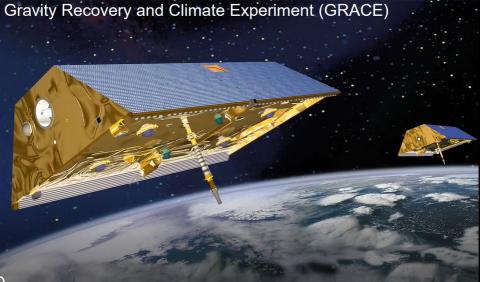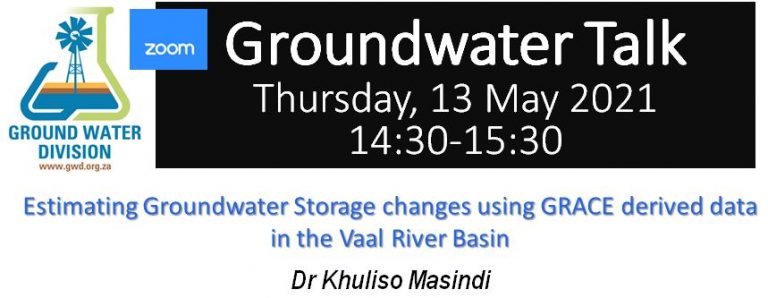Event Debrief: GWD Talk on Estimating Groundwater Storage changes using GRACE derived data in the Vaal River Basin
Event Debrief: GWD Talk on Estimating Groundwater Storage changes using GRACE derived data in the Vaal River Basin


"Thank you for this mind-boggling presentation"
Mr Kwazi Majola (Gauteng Branch Chair) thanked Dr Khuliso Masindi after he shared with attendees on latest GRACE research results.
ABOUT THE TALK
The Vaal River Basin (VRB) is a key economic zone in the interior of South Africa; it is marked by intense mining, industrial, and agricultural activities. It experiences a predominantly semi-arid climate with an average annual rainfall of 570 mm. Population increase and the recurrence of drought places water supplies under pressure. Increasing groundwater use in the VRB as an alternative water source can reduce pressure on water supplies. The successful development and use of groundwater in the basin will largely depend on improved understanding of the groundwater system. The purpose of the study was to quantify the groundwater storage and to assess the effects of both human and natural stressors on groundwater resources. Groundwater storage was estimated by subtracting soil moisture and surface water storage from the Grace Recovery and Climate Experiment (GRACE) based terrestrial water storage. The GRACE-based groundwater storage was estimated to be 39.72 km3 from 2003 to 2014 with an increase of 3.31 km3/year. The GRACE groundwater storage captures annual variability in water storage distribution. The GRACE groundwater storage also mimics the rainfall amount with a time lag of less than six months. The findings of the study shows that the GRACE-derived data is inapplicable for smaller catchment. The GRACE groundwater storage was not validated in the current study because of the sparsity of groundwater level data in the basin. This study demonstrates that the gravimetric data derived from the GRACE satellite provide an opportunity to assess groundwater storage changes in large basins (150 000 km2). The application of integrated approaches that involve space-based observations such as gravimetric data from the GRACE satellite and ground data to study groundwater systems in complex basins is of great value in data-scarce basins. The space-based observations are not a replacement of ground monitoring and collection of hydrological data, more effort must be directed to collecting and monitoring groundwater data to help understand how the quantity of groundwater is evolving in real time for better groundwater management.
Q&A SESSION
Q - Mothatego: when doing the comparison of TWSAWb vs GRACETWSa there was some kind of "INVESION" or disagreement between 03 and 05 e.g TWSAWb showing increase while GRACETWSa showing decrease. What could be the significance of that?
A (summerised) : GRACE data is not only looking at the area but also possible contributions by the surrounding catchments. There is a resolution challenge. The GRACE is not applicable for smaller scale as also reported by other studies across the world. Bigger regions with large fluctuations and water movements will benefit from GRACE.
Q: What about the influence of mining activities?
A: Yes, that will have influence but it was not the specific focus of this study. There is another study where we are looking at groundwater levels 40 years of data where we did see a decrease in mining activities in some areas did result in the increase in water levels and when we take into account the other parameters also there was an increase but looking specifically at GRACE data we can see that it is not massive events. On a larger scale it is coarse but on local scale it will make a difference.
Q - Zaheed: Good afternoon. Thank you for this insightful work. I myself worked extensively with GRACE data across SA, and we worked with down-scaling in particular and I am glad that you mentioned it. Looking at the trend we see an increase in groundwater storage in some parts of Africa across the years and when we look at the downscale data in terms of groundwater levels - it is actually declining over the years. Our opinion on that is that on the local scale pumping has a great influence on our groundwater levels but regionally there seems to be more groundwater in our basins than there was before. Any comments on that?
A: *____.. I agree and we can chat more about the down-scaling techniques that you use (Regional vs Local scale) , this and we can learn more together on how to use space base observation in general .
Q - Kwazi: GRACE sees water. How deep does GRACE go? Shallow to deep aquifers?
Q- via Registration: What is the interaction between groundwater and surface water in the area? Can the results be used in the Water Use license granting or applications?
Interested to learn more? Please feel free to contact Dr Masindi via [email protected]
TALK RESOURCES
GWD_TALK-presentation_KHULISO-MASINDI
